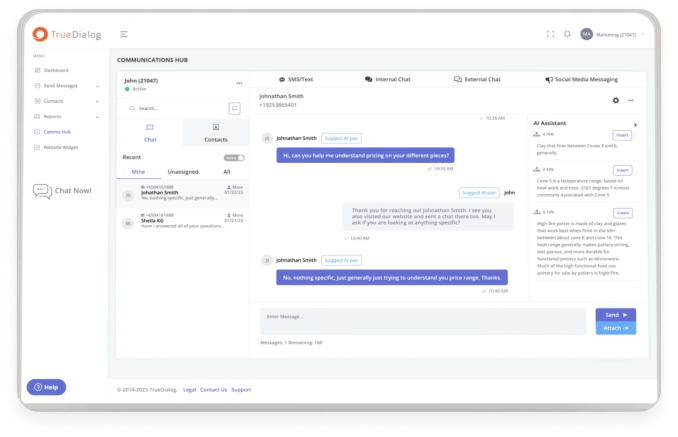The Need for Bulk SMS for Universities and Colleges
College may be about education, but it’s also a time for many students to be on their own for the first time, navigating a new world where they are accountable for managing their lives. Older students may be managing families and work responsibilities on top of school. For colleges and universities, email is often the go-to for reaching students with important messages, yet email has a dismal open rate and even worse response rate. Is bulk SMS the answer for universities?
Gartner reports that people only open about 20% of the emails they receive and respond to just 6% of those. Compare that with SMS open rates as high as 98% and response rates at 45%. And that’s for the general public. Students who fall into the younger demographic are even less likely to open emails. One study found that more than 50% of students don’t read emails from their institutions, even though a single missed communication can have detrimental outcomes for the student.
Even while some universities cut back on the number of emails they send students to encourage higher open rates, students may not be used to communicating through emails or are trying to juggle multiple aspects of life. Their language is quick, brief, and easy, most often spoken through social media and messaging apps. Retraining students to use email is an uphill battle. Instead of fighting it, universities need to embrace how students communicate.
Bulk SMS for universities is essential to connect with students where they are and how they interact, which is typically on their mobile devices on the go. While they have access to email from these devices, it is clear they aren’t always checking their emails, at least not regularly enough to avoid missing important deadlines and messages. And even when they are, they can have hundreds of emails to sort through, something they postpone or even ignore because of the required time commitment.
Related: Higher Education Text Messaging: Everything You Need to Know About TCPA Consent Laws
Does this mean that higher education institutions have to give up email altogether? Absolutely not. In fact, texting and email can go hand in hand. The same goes for texting and social media, voice calls, and secure portals. Texting is a way to get students’ attention.
Blending SMS Texting with Emails and Social Media
Some universities have transitioned to social media to reach students. Yes, students spend a lot of time on social media, but the problem is, there are multiple social media platforms, and they aren’t always connected. That means a university has to go into each platform separately and craft a message, and there’s no integration to easily track open rates.
Bulk SMS for universities, on the other hand, is universal, and everyone uses it throughout their day. Universities no longer have to worry about which social media platforms students use, spending time crafting messages per platform, or analyzing success rates across platforms. Texting becomes a unified communication strategy.
If a message is better suited for email because of the length of content or security reasons, for instance, higher education institutions can send bulk SMS to direct students to an email. The students receive a push notification to check their email for an important message about an upcoming deadline, as an example. Bulk SMS for universities is also helpful to direct students to their secure online portals, where they can tend to-do items quickly and securely.
Universities may also use the SMS platform on its own to remind students of an appointment, a payment due date, class registration dates, or any information that can help students stay on top of their academia. A research study on texting and students found that approximately 85% of students reported that text messages from their universities promoted them to complete a task, informed them about something they didn’t realize they needed to do, and/or was useful in helping them get everything done for college.
Related: Higher Education: Top 12 Statistics on Why Universities & Colleges Should Be Texting Students
Another study of the use of SMS in higher education revealed that students rated text messaging as “very useful” for academic purposes. They cited saving time, resolving administrative issues, convenience, and ease of use as their top reasons. Texting these messages is much more effective than email, ensuring more students don’t just get the message but see the message and have a fast way to respond.
Higher Education Texting Platforms
Bulk SMS for universities is easier than you may think. It doesn’t require heavy lifting or massive technology investment. Many higher education institutions have already implemented a bulk SMS solution as a way to target messages, notifications, and alerts to students, as well as faculty, staff, and parents.
The ease of deployment will depend on the texting platform’s API. It should allow you to seamlessly integrate the platform with your CRM and other institutional and marketing apps. It should also be intuitive and easy to use at scale.
Texting is effective for a variety of audiences and communication types:
Admissions and enrollment
The majority of students research multiple colleges and universities before they apply, giving you a prime opportunity to set your institution apart from the competition and provide a responsive, supportive environment, even before a prospect becomes a student. You can use SMS to reach out to prospective students to answer questions, encourage tours and advisor meetings, and remind them of application requirements and deadlines.
Once they have applied, you can use the texting platform to engage in one-on-one, two-way texting to humanize your communications for a more personal touch. Answer questions and keep them updated on the timelines, next steps, and acceptance notifications.
Student retention and success
University students can quickly fall behind, especially during their first year as they get their feet on the ground and learn how to “do” college. SMS is a great way to stay connected with students along their journeys by sending them real-time messages, notifications, and reminders to keep them on track. You can also connect them with university resources to help them get more engaged and feel part of the institution.
This sense of belonging is critical to student success. A recent study by the National Survey of Student Engagement (NSSE) discovered that institutions that successfully promote belonging and invest in a supportive environment realize higher rates of student retention.
Financial aid
As many as 85% of first-time, full-time, degree/certificate-seeking undergraduate students were awarded financial aid in the past couple of years. As common as financial aid is, it still remains a complicated and daunting process for students and parents alike. Bulk SMS gives universities an easier and more effective way to help students navigate FAFSA and scholarship opportunities.
And while financial aid information can often be subject to privacy compliance, texting is a great way to get students to log in to their portal to complete required documents and make payments. You can send messages to parents as well, reminding them of upcoming due dates and other important messages related to financial aid.
Urgent Alerts
Bulk SMS is ideal to send urgent messages to students, faculty, and staff. Some SMS platforms enable you to send mass student SMS text, email, and voice message alerts with a single click, as well as continue the dialog one-to-one if a student replies to the text. You can also segment your audience by location. For example, if your university has multiple campuses, you can send a mass text message to only the students affected by the urgent event.
Career services
Career services are an important part of a student’s life as they think about what comes after college and get closer to graduation. Texting is a useful way of communicating important information about upcoming career fairs, campus speakers, student events, job listings, and internship opportunities.
Alumni engagement
Alumni are an important part of any higher education institution, yet they can be challenging to reach once the school deactivates their school email address. Bulk SMS is effective in keeping in contact with alumni and encouraging them to get involved in alumni events and donation campaigns. The best texting platforms will enable you to segment your audience so you can customize messaging to their preferences.
How Universities Can Maximize Bulk SMS
There are a few valuable SMS capabilities you should consider when evaluating bulk SMS for universities. A texting platform needs to enable multiple school agents or staff members to simultaneously communicate with students using the same threaded conversation. This will allow your institution to respond faster to issues and questions and provide a unified conversation history.
Another important feature is the ability to send both bulk SMS and one-to-one SMS. While one-to-millions mass SMS texting is effective for some messages, you want your staff and faculty to be able to engage in more personal messaging in certain circumstances.
You will also want the ability to schedule SMS texts or send messages on demand, with access to reports that drill into message history, users, recipients, open rates, and similar details. SMS shortcodes and texting long codes should also be an option.
SMS is a powerful tool higher education institutions can add to their communication toolbox. When optimized, it is proven to have a higher success rate than any other form of communication. Contact us to learn more about bulk SMS for universities and how you can support more effective and efficient student engagement.





